Mushkin Reactor 1TB SSD Review
by Kristian Vättö on February 9, 2015 11:32 AM EST- Posted in
- Storage
- SSDs
- Mushkin
- Silicon Motion
- SM2246EN
- Reactor
- Micron 16nm
Random Read/Write Speed
The four corners of SSD performance are as follows: random read, random write, sequential read and sequential write speed. Random accesses are generally small in size, while sequential accesses tend to be larger and thus we have the four Iometer tests we use in all of our reviews.
Our first test writes 4KB in a completely random pattern over an 8GB space of the drive to simulate the sort of random access that you'd see on an OS drive (even this is more stressful than a normal desktop user would see). We perform three concurrent IOs and run the test for 3 minutes. The results reported are in average MB/s over the entire time.
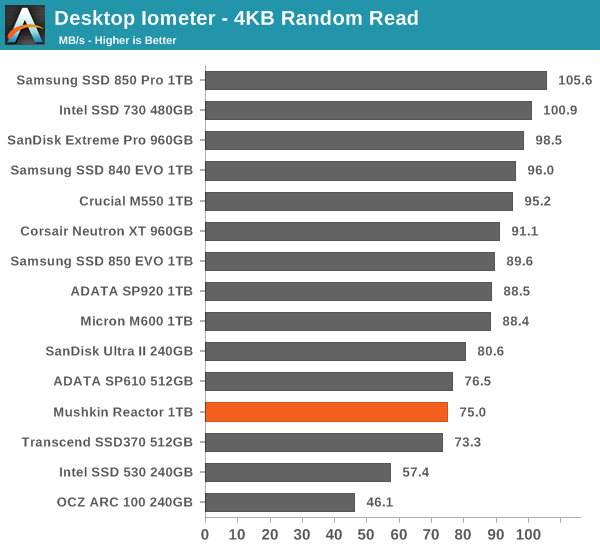
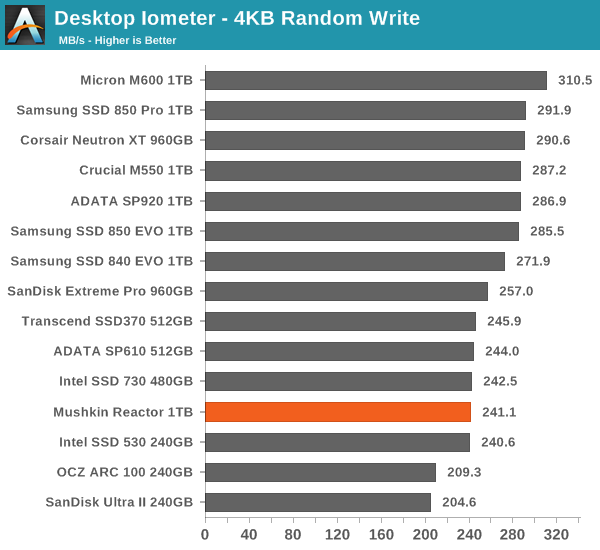
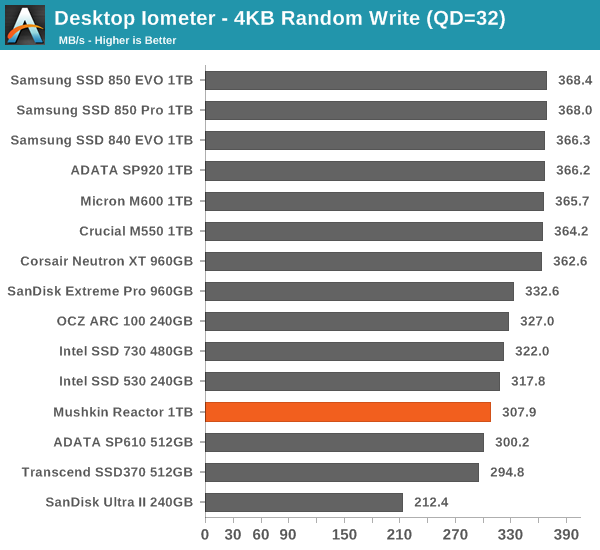
Random performance is typical to SM2246EN, which isn't bad but there are drives with better peak performance.
Sequential Read/Write Speed
To measure sequential performance we run a 1 minute long 128KB sequential test over the entire span of the drive at a queue depth of 1. The results reported are in average MB/s over the entire test length.
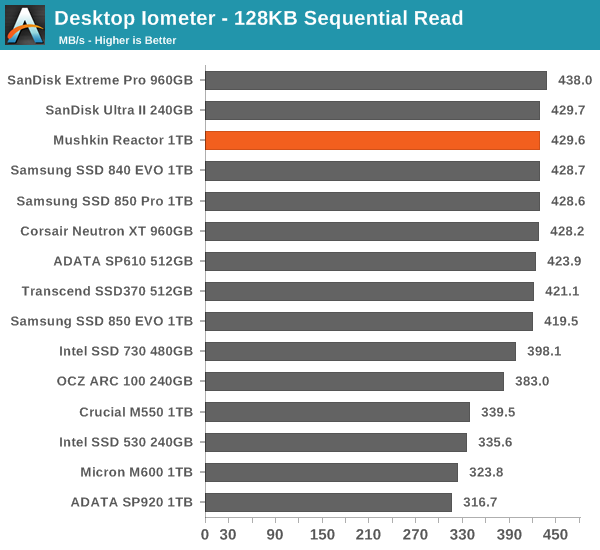
Sequential write performance is a bit lower compared to the rest of the SM2246EN based SSD, which I suspect is due to the additional capacity and the increased LBA tracking due to that.

AS-SSD Incompressible Sequential Read/Write Performance
The AS-SSD sequential benchmark uses incompressible data for all of its transfers. The result is a pretty big reduction in sequential write speed on SandForce based controllers, but most other controllers are unaffected.
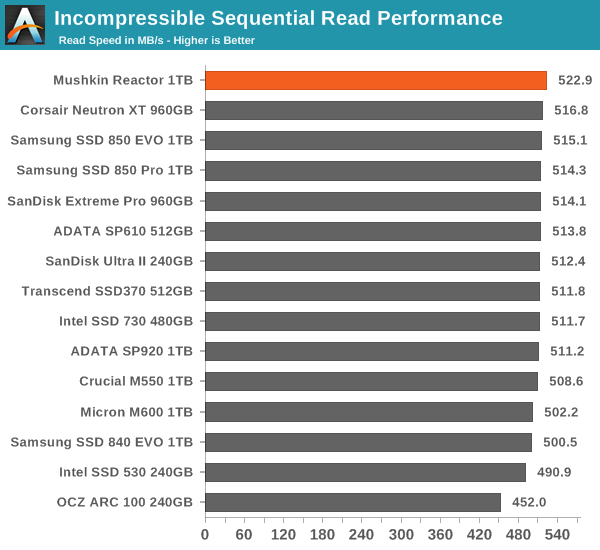
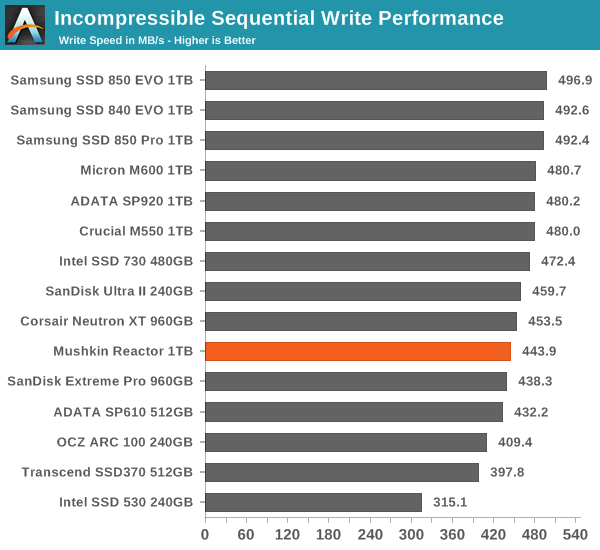










69 Comments
View All Comments
prime2515103 - Monday, February 9, 2015 - link
Is it just me or are SSD review getting really boring? Every time I see a new one I think, "Maybe something new and exciting this time..." but it never happens. I think SATA needs to be put to rest.piroroadkill - Monday, February 9, 2015 - link
Yeah, SATA3 is making everything boring as hell now.ddriver - Monday, February 9, 2015 - link
That's a limiting factor only on sequential access. There is still huge potential to be harnessed for random access, but nobody seems to be in a hurry to boost IOPS.Kristian Vättö - Monday, February 9, 2015 - link
SATA, or more accurately AHCI, is the limit when it comes to IOPS/latency.cm2187 - Friday, February 13, 2015 - link
I can only talk for myself but personally I could use more size than speed. There is very little of what I do that would give me a different experience at twice the speed of the current SSD specs. But give me a 4TB SSD as cheap as 6TB HDD are today and now I can replace all these spinning disks.0ldman79 - Wednesday, March 4, 2015 - link
Agreed.I might keep a couple of mechanical drives, but I'd love for the price to be closer to the mechanical drives for the capacity.
Too bad that's not the way our market works in much of anything these days.
Solandri - Monday, February 9, 2015 - link
PCIe actually doesn't make that big a difference. Your perception of how fast/slow things are is in terms of seconds you have to wait. These benchmarks are in MB/s which is the inverse of your perception. If you plot these benchmarks correctly in sec/MB, all these SSDs are pretty much the same, and the PCIe SSDs only give you a small fraction of the speedup you got going from SATA2 to SATA3. e.g. Imagine you need to read 1000 MB.10 sec = 100 MB/s HDD
4 sec = 250 MB/s SATA2 SSD (6 sec improvement)
2 sec = 500 MB/s SATA 3 SSD (2 sec improvement)
1.25 sec = 800 MB/s PCIe SSD (0.75 sec improvement)
nathanddrews - Monday, February 9, 2015 - link
This is very true, but doesn't make me want it less. :-DWhat kills me is the lack of "affordable" 2TB+ drives. How is that we go from $400 for 1TB in a 2.5" drive to $1,500-$4,000 for 2TB? I expected that all these die shrinks and 3D technologies would have made 2TB+ SSDs possible in the ~$700-$900 space, but there's nothing to buy! FFS, what gives?
DanNeely - Monday, February 9, 2015 - link
It's a giant game of chicken, and no one wants to be the first to kick over the enterprisy pricing gravy train. We saw the same thing a few years ago when 512TB drives started at $350 but the cheapest 1TB ones were well north of $1k.At the risk of sounding overly cynical; I suspect the first vendor to blink will be whoever is first to either get the higher nand density or the 32 chip controller needed to make a 4TB flash drive in a 2.5" form factor.
Cogman - Monday, February 9, 2015 - link
Mostly it comes down to demand. Nobody is really demanding 2TB SSD drives. As a result, there is little competition and little incentive to make a $800 drive (even though it is totally feasible).